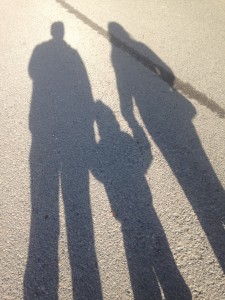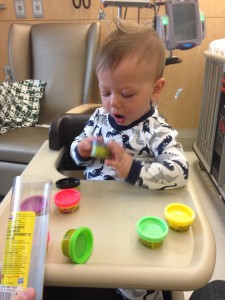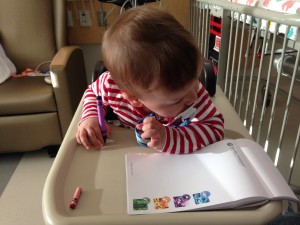 Hyper IGM, bone marrow transplant, immunodeficiencies, what does this all mean and why are we doing all this to our son Idan? For those of you still trying to make sense of the whole process, I am going to try and simplify it so that it is easier to follow.
Hyper IGM, bone marrow transplant, immunodeficiencies, what does this all mean and why are we doing all this to our son Idan? For those of you still trying to make sense of the whole process, I am going to try and simplify it so that it is easier to follow.
What is X-Linked Hyper IGM?
Our son Idan was born with a genetic mutation passed along on his X Chromosome. The syndrome itself almost always only affects boys as girls have two X’s and are mostly just carriers. Since it never appeared in our family before, we had no way of knowing Idan had this until he got sick in April. Hyper IGM is so rare (2 in 1,000,000) that it is never something that is tested for (and most doctors probably never even heard of it).
So how does it affect Idan? Basically the gene mutation means that he is missing a protein that his T-Cells need to produce (called CD40 Ligand) that is necessary to produce Antibodies, or immunoglobulins. This protein is also used by the T-Cells to communicate (AKA tango with) with the B-Cells and allow them to do their job as needed. This leaves a huge hole in his immune system. Imagine an army with lots of foot soldiers (T-cells) and Special Forces (Immunoglobulins) constantly at battle with the world around us. This army keeps us all safe on a daily basis, and when we encounter viruses or bacteria that the foot soldiers cannot not fight off, the special forces take over. Idan has no ability to create special forces at all, so he cannot recognize or destroy any viruses (think flu, cold, mono, herpes, etc.) so those can kill him. He also has lots of T-Cells that do not know the basics of fighting because the B-Cells cannot give them proper instructions. Therefore, he is susceptible to many opportunistic infections (like the PCP/PJP that almost killed him in April) that the rest of us just fight off without even feeling sick.
What are the dangers of Hyper IGM?
First, recurrent infections can lead to major organ damage. Idan’s lungs were in very bad shape after beating the pneumonia back in April. As time goes by many Hyper IGM kids have orgran damage to the lungs and liver from these infections. Second, opportunistic infections such as cryptosporidium, a parasite found in water, can kill Hyper IGM patients as there is no cure for cryptosporidium without a functioning immune system. Lastly, cancer, malignancies and liver and central nervous system diseases. As time goes by there are higher risks of all these, leading to a median age of 24 for Hyper IGM patients. Our immune system is constantly fighting off cancers before they even become an issue and our son’s immune system cannot do that.
So what can be done?
In the short term we have been treating Idan with immunoglobulin replacement therapy. These are the weekly infusions of IGG’s which is one of the 4 types of antibodies he is missing, and the only ones medicine knows how to replace. This, coupled with major lifestyle changes (like isolation, bottled water, etc.) has kept Idan safe since April. Some Hyper IGM patents can live for many years this way, but since Idan’s mutation is the most severe form (i.e., he expresses no CD40L at all), the odds of this being enough are against him. The only known possible cure is a Bone Marrow Transplant which essentially would replace his entire army with a donor’s army that works properly. But this is a complicated and risky process with high risks and no guarantees.
So What Is a Bone Marrow Transplant (BMT)?
Currently, there is no way to fix the gene mutation that causes Hyper IGM, but there is a way of replacing the bone marrow and giving Idan a new immune system. One can look at the bone marrow as the army base that the immune system (as well as the blood) is created and trained in. The idea is, if Idan’s b-cells cannot produce the protein he needs, lets give him a new army base, with soldiers that know what they are doing. But it is not that simple:
1) Currently the army base in his body is filled with soldiers (even if they’re not too smart), so there is no vacancy for him to host someone else’s army.
2) Idan’s body (AKA, the equipment, building and land that needs protection) is a perfect match with his current army, and no other army (AKA the donor’s bone marrow) is going to know how to work it in the same way.
3) Any gap in the protection that his army is giving him (albeit a lazy one) will open up his body to infections.
4) In order to create a vacancy in his army base so that a new army can move in, the old one needs to be eliminated entirely. The way they do this is with chemotherapy, which has the nasty side effect of destroying the bone marrow, and in our case we want that. However, that process comes with its own risks of toxicity to the body.
With all the risks involved Amanda and I decided that BMT is the way to go. BMT will give Idan the best chance at a long and healthy life. We did a lot of homework and spoke to dozens of bone marrow teams around the world. We decided on Seattle because of the new type of chemo drug they are using (Treosulfan) that is less toxic than others. If all we need is to clear the army base from soldiers why bomb random cities and cause damage to the whole land?
How will this cure Idan?
First they will use chemo and ATG to eliminate his bone marrow and suppress his immune system. This is what we are doing from Day -6 to Day -1. We then give Idan a day of rest while the chemo in his system continues to clear out all the soldiers from his army bases (including the civilian side of his bone marrow that produces red blood cells). On Day 0 the transplant date, we will infuse Idan with the donor’s army. His army has been found to be a 10/10 match to Idan’s. While this is great news, it is not the whole picture. This new army is not really going to understand how to relate to all of Idan’s body parts, and will most likely still want to attack some of it (this is called Graft ss Host disease, and it happens with 70% of the transplants from unrelated donors like Idan’s). For this reason they use the ATG, and the other immunosuppressants to allow the new army to come into the empty base, but forces it to unpack, train, and start patrolling very very slowly. Giving the new army more time to get adjusted to Idan’s body is a delicate balancing act that will happen over the next year. Since they are letting the bone marrow come in and start working very slowly there is a longer time where Idan is lacking any working immune system and will be kept in isolation as well as be given drugs to protect him.
So what is next?
Day -6 to day 0 we are clearing his bone marrow and making room. On Day 0 he gets the transplant, and we start counting days until the bone marrow travels to the base and starts setting up shop. We hope to hear around Day 22 that they have reached the base and that would be engraftment. We will then wait until we see his counts go up. The first type of soldier to come back (or, better put, to “grow”) is his neutrophils (which work fine now, but we have to get rid of them with the rest of the army) and they will wait until that level is good enough to get released to isolation at our apartment. This will happen between day 30 and 50 and then we will count to day 100 before they might let us go back to NYC. From then on and until around 2 years post transplant Idan will still have a weak immune system. Our hope is that around one year post-BMT, his new army will be strong enough and acclimated to his body to start reducing the supplemental protections we are giving him. Along the way there are going to be many scary events but we and the medical team will deal with them as they come up.
In a few years, when Idan can go to nursery school, play with other kids, take swimming lessons, play in the park and ride the swings all with the protection of his donor’s army, we will know we did the right thing to ensure Idan has a normal, healthy and happy life.
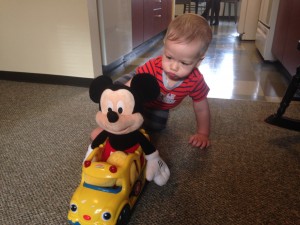 It has been a week since they put Idan on the higher dose of steroids for the GVHD and it seems to have done the trick. So tomorrow we will start tapering the dosage and the long road to get off the steroids. With GVHD there is always a chance that it might return when we start reducing the dose, so the doctors will be monitoring his skin closely as we cut down by 10% every 5 days or so. This means that we will have to deal with all the side effects and extra meds that the steroids come with for a couple more months. It has been hard to see Idan have mood swings and laugh or cry for no apparent reason as well as deal with his increased appetite. After a large breakfast at 7:30AM he starts asking for lunch at 10:30AM and so on. On the bright side we are getting a taste of how Idan will be as a teenager so we will be well prepared 🙂
It has been a week since they put Idan on the higher dose of steroids for the GVHD and it seems to have done the trick. So tomorrow we will start tapering the dosage and the long road to get off the steroids. With GVHD there is always a chance that it might return when we start reducing the dose, so the doctors will be monitoring his skin closely as we cut down by 10% every 5 days or so. This means that we will have to deal with all the side effects and extra meds that the steroids come with for a couple more months. It has been hard to see Idan have mood swings and laugh or cry for no apparent reason as well as deal with his increased appetite. After a large breakfast at 7:30AM he starts asking for lunch at 10:30AM and so on. On the bright side we are getting a taste of how Idan will be as a teenager so we will be well prepared 🙂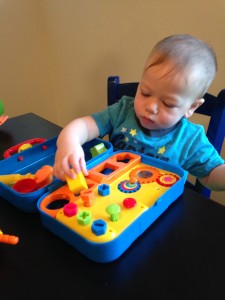 Still, it is hard to forget that we are still living in limbo and do not know if Idan will reject his graft or reach a point where his donor graft stabilizes. They will test chimerism again on March 10th and like with each of these tests before, it is a toss up and we really do not know what to expect. the good news we are focusing on is our eminent return to NYC. If tapering the steroids in the next couple of weeks goes well we can continue all our care in NYC with our pediatrician and immunologist. We will be bringing back a boy with an even worse off immune system, as he is still on two immunosuppressants, but we hope our life can start to return to normal. Keeping Idan safe, healthy, and happy is definitely going to be a big challenge in NYC and we hope that by the time we head back in mid-March the weather in NYC will improve.
Still, it is hard to forget that we are still living in limbo and do not know if Idan will reject his graft or reach a point where his donor graft stabilizes. They will test chimerism again on March 10th and like with each of these tests before, it is a toss up and we really do not know what to expect. the good news we are focusing on is our eminent return to NYC. If tapering the steroids in the next couple of weeks goes well we can continue all our care in NYC with our pediatrician and immunologist. We will be bringing back a boy with an even worse off immune system, as he is still on two immunosuppressants, but we hope our life can start to return to normal. Keeping Idan safe, healthy, and happy is definitely going to be a big challenge in NYC and we hope that by the time we head back in mid-March the weather in NYC will improve.